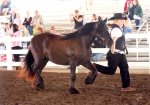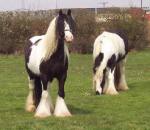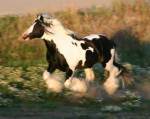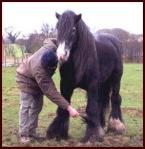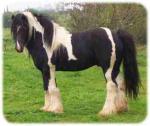The Lesser Evil
By Maria Borkowski and Paula Blough in Facebook’s Pro Horse Slaughter– I CARE about the horse industry, January 2012
A Texas woman and her husband had several horses. One day the woman’s husband left her and the horses. She tried to care for them but could not afford to feed them. The horses began to starve. She begged people to take them, but there is no market in Texas for horses unless they are of the highest quality. No one would even take them in for free. Most of the horses died over the winter, and the rest disappeared after turning into skeletons.
A man in Montana bought four horses from a breeder for $10 each to keep the horses from going to slaughter. He didn’t realize how much it costs to care for horses. He ended up starving the horses he was trying to rescue.
A woman in Kansas had a horse and two saddles stolen. Four days later, the horse was found in a field 30 miles away. She had been shot in the head and left for dead. She somehow survived but is now blind in one eye. The thief obviously valued two used saddles more than the life of a horse.
Situations like these are happening all over the country. Horses are being turned loose to try to fend for themselves. Ranchers in some parts of the country are having random horses show up in their pastures. In some parts of the United States, people are tying their horses to fence posts with their papers and signed transfers stuffed in the halter. Their owners can no longer afford to care for them. They turn them loose or drop them off hoping someone will find them and take them in. This is an epidemic hurting our nation’s horse population. Horses are suffering needlessly because there is no longer a market for them.
The market has been flooded with “unwanted horses.” The unwanted horses used to go to slaughter, but the three horse processing facilities in the U.S. were shutdown in 2007. Just as the name implies, an unwanted horse is a horse that has become unwanted by its owner. The American Association of Equine Practitioners or AAEP defines unwanted horses as “horses which are no longer wanted by their current owner because they are old, injured, sick, unmanageable, fail to meet their owner’s expectations (i.e. performance, color, or breeding), or their owner can no longer afford them” (Unwanted 2). Regardless of the reason, these horses no longer have permanent homes.
Beginning with 2007, the Unwanted Horse Coalition estimates 170,000 horses become unwanted every year (Unwanted 2). These magnificent animals shouldn’t have to suffer. “How can the unwanted horses be cared for?” is the question that arises. There are many options available, but each of these is an insufficient solution to the unwanted horse problem.
The first option a horse owner might consider is selling the unwanted horse or horses. The problem with this is that there is no market for horses in the United States today unless they are of the highest quality. The reason for this downturn in the market is the high price of hay and the flooding of horses in the market that would have gone to slaughter before the slaughter ban. Horses that once cost $500 are selling for $50 (Jarvie). There are many cases where the horses sell for less than the fee the sale barn charges a seller. Thus, the seller ends up having to pay the sale barn in order to sell the horse. Before the ban, the buyers who purchase for the slaughter facilities would pay between $300 and $700 for a horse. These were the low-selling horses. These people want to make a profit; they are going to buy the cheaper horses that no one wants rather than the good horses in order to make a better profit. A study that examined horses at both auctions and slaughterhouses found that slaughterhouses only purchase horses not viewed by other buyers as viable working animals. These horses bound for slaughterhouses had poorer foot and body condition, were older, and had more severe behavioral problems than other horses at auctions (Jarvie). This shows that it is typically horses that are not useful, and therefore not as desirable, that are sent to slaughterhouses. It is also difficult to sell a horse directly to a buyer. In many cases, such as the example of the Texas woman, it is even difficult just to give away a horse.
Another option for an unwanted horse is to send it to a horse rescue or a horse shelter. Horse rescues across the country have been filled to capacity with unwanted horses. Many shelters have to turn away pleading owners because they have no more space available or not enough funds to care for another horse. More horses are being sent to rescues than ever before while at the same time donations are at an all-time low (Mack). Many shelters are even having horses that they had adopted out be brought back to the rescue because their new owners could no longer afford to care for them. “’There are a lot worse things than death,’ said Janet Tuttle, owner of a horse rescue in Maine. ‘People have been leaving horses in barns and fields to die simply because they cannot afford to care for them’” (qtd in Mack).
Being unsuccessful with finding a new home for their horse, a horse owner may decide to try to keep the horse, and let it live out the rest of its life. The AAEP estimates that the minimum yearly cost to care for a horse is $1,825 (“FAQ…”). This figure does not include veterinary and farrier (hoof care) expenses not to mention horses live a long time. The average lifespan of a horse is 30 years (AVMA). This means the absolute minimum cost of caring for a horse for 10 years is over $18,000. With the economy being down, it is hard for many horse owners to care for an animal that costs them more money than it brings in. Additionally, the recent drought in parts of the United States is making hay harder to find and thus, more expensive. This makes horse care especially hard for people who own horses just for recreation. There have been more and more reports of people starving their horses to death because they cannot afford to feed them, but they also cannot find a new home for their horses. “’It’s heartbreaking,’ said Kathy Grant, who runs a rescue center in drought-stricken eastern Tennessee. ‘The back roads are where you find them — all skin and bone, just hanging their heads in the pastures, dying’” (qtd in Jarvie).
Desperate horse owners have also been known to turn their horses loose or drop them off in people’s pastures hoping that someone will find them and take care of them. Horses that have been cared for by humans all their lives cannot survive in the wild. Other people are having enough trouble caring for their own animals; it is wrong to put one’s burden on someone else.
The final option for an unwanted horse is to have the animal put down. Euthanasia can be quite costly in itself, but there are other faults with this choice. Something has to be done with the horse’s remains. There are four main ways to do this: burial, cremation, rendering, or a landfill. A person may want to bury the horse on their property. A backhoe will have to be rented or a person will have to be paid to come dig a hole for burial. This is not cheap. Also, many local ordinances would not allow the burial of such a large animal. Cremation is also quite expensive. The actual cremation cost over $1,000 in most cases. Then there is the pick-up fee which can be a couple hundred dollars. Cremation services are also difficult to find for large animals. On top of all that, the average horse’s ashes weigh forty pounds (“Euthanasia…”). This takes up quite a bit of space. Rendering services are also few and far between. For a relatively low price, renderers will come get a dead horse. They process the horse’s body and give the horse new uses. The meat is used to feed the big cats in zoos. The skin, hooves, and bones can all be used. Lastly, there is the landfill. If the local landfill allows, a horse’s body may be disposed of there. This is the least expensive method, but the thought of an animal rotting in a landfill can be unbearable.
The best solution for the unwanted horses is a different form of euthanasia. According to the American Veterinary Medical Association (AVMA), “there are three methods acceptable for the euthanasia of horses: chemical euthanasia, with pentobarbital or a pentobarbital combination (euthanasia solution); gunshot; and penetrating captive bolt” (AVMA). Typically when a horse is put down, chemical euthanasia is used. Penetrating captive bolt is similar to a gunshot, but it does not release a projectile. This method induces death more rapidly than chemical euthanasia (AVMA). This method of euthanasia is also how the horses in U.S. slaughterhouses were killed.
On the other hand, slaughterhouses in Mexico are unregulated. Horses are typically immobilized by severing the spine with a knife. With the heart beating, they’re hoisted by chain wrapped on a hind leg. A cut to the throat allows horses to bleed out. In 2007, Congress cut funding for horse slaughter inspections, putting the facilities out of business. From 2006 through 2010, horse imports from the U.S. to Mexico for slaughter increased 660% (Shames 12). Many of the unwanted horses are now being shipped hundreds of miles to suffer an inhumane death in the hands of Mexican slaughterhouses. Last year, 137,984 horses were shipped to Mexico and Canada for meat production. Before the ban, 90,000 to 100,000 horses were processed each year in the United States (AVMA). Though it sounds like a lot of horses, this is nothing considering there are 9.2 million horses in the United States (AVMA). This means only 1% of the horse population actually goes to slaughter. American slaughterhouses are held to much higher standards. Veterinarians supervised the killing of all horses in U.S. facilities (AMVA). The animals’ lives are ended respectfully and humanely.
Horse slaughter is also good for our economy. It provides many jobs for Americans and brings in a considerable sum of money from exports. This helps alleviate our trade deficit. In the last full year of slaughter, the U.S. exported $65 million dollars’ worth of horse meat (Shames 8). Horse products add approximately $650 million dollars to the U.S. economy.
Slaughter also gives an unwanted horse’s life more value. Most horse meat is exported to European and Asian countries for consumption. However, an often overlooked demand for horse meat comes from zoos. Large carnivores, such as lions and tigers, require a lot of high-quality protein in their diets (AVMA). Horse meat is a healthy choice for the big cats. This lean meat has 40% fewer calories, 50% more protein, and up to 30% more iron than beef (AVMA). The horse’s hide is made into leather, and the hooves and bones are made into glue, fertilizer, and several other products.
Horse slaughter should be reestablished in the United States due to the inadequate alternatives for unwanted horses; its advantage over other disposal options; and the benefits of horse products. This is the most humane way to deal with the numerous extra horses. Horses shouldn’t have to suffer. It’s heartbreaking hearing stories of horses starving to death because no one could take care of them. After looking at the alternatives for the overload of unwanted horses, it is clear that horse slaughter plants in the U.S. should be reopened.
Works Cited
AVMA Communications Division. “Frequently Asked Questions.” American Veterinary Medical Association. 5 Sept. 2008. Web. 18 Oct. 2011.
Carpenter, Tim. “Rhapsody Vanishes Into Ether of Slaughter Market.” The Topeka Capital Journal. 15 Oct. 2011. Web. 19 Oct. 2011.
“Euthanasia – What You Need To Know About Putting a Horse Down.” American Horse Rider & Horses and Horse Information. Winter 1998. Web. 19 Oct. 2011.
“FAQ About Unwanted Horses.” American Association of Equine Practitioners. 2011. Web. 14 Oct. 2011.
Jarvie, Jenny. “Drought is a Hard Time for Horses.” Los Angeles Times. 13 Jan. 2008. Web. 19 Oct. 2011.
Mack, Sharon. “Maine’s Horse Rescue Shelters Struggling to Save Animals in Tough Times.” Bangor Daily News. 15 May 2011. Web. 19 Oct. 2011.
Shames, Lisa. Horse Welfare: Action Needed to Address Unintended Consequences from Cessation of Domestic Slaughter. DIANE Publishing, June 2011. Print.
Unwanted Horse Coalition / The American Horse Council. “2009 Unwanted Horse Survey.” Unwanted Horse Coalition. 2009. Web. 18 Oct. 2011.




































































